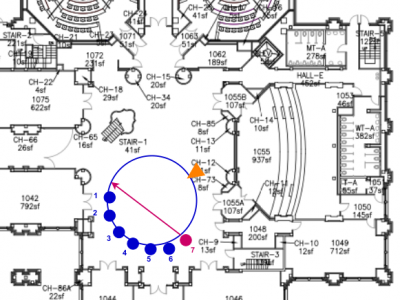massive MIMO
The data repository contains detailed information about theoretical model used in the simulations and data sets obtained with simulations for the article with the title "Maximum-Likelihood Detection with QAOA for Massive MIMO and Sherrington-Kirkpatrick Model with Local Field at Infinite Size". For a comprehensive understanding, please refer to the main article. We apply Quantum-approximate optimization algorithm (QAOA) on maximum-likelihood (ML) detection of massive multiple-input multiple output (MIMO) systems.
- Categories:
 231 Views
231 ViewsWe conducted a massive MIMO channel measurement experiment in an indoor setting on the Rice University campus. We used a 64-antenna RENEW software-defined massive MIMO base station and seven software-defined clients in a large open area inside a building hall. We fixed six of the clients in a circle,15maway from the base station. The seventh node was placed on a robot where we moved the robot across the hall starting from the location of the first client to the last. We moved the robot along the path with different speeds, i.e. with0.5m/s,1m/s, and2m/s.
- Categories:
 255 Views
255 ViewsThis is a CSI dataset towards 5G NR high-precision positioning,
which is fine-grained, general-purpose and 3GPP R18 standards complied.
The corresponding paper is published here (https://doi.org/10.1109/jsac.2022.3157397).
5G NR is normally considered to as a new paradigm change in integrated sensing and communication (ISAC).
- Categories:
 5442 Views
5442 ViewsThis dataset contains thousands of Channel State Information (CSI) samples collected using the 64-antenna KU Leuven Massive MIMO testbed. The measurements focused on four different antenna array topologies; URA LoS, URA NLoS, ULA LoS and, DIS LoS. The users channel is collected using CNC-tables, resulting in a dataset where all samples are provided with a very accurate spatial label. The user position is sweeped across a 9 squared meter area, halting every 5 millimeter, resulting in a dataset size of 252,004 samples for each measured topology.
- Categories:
 5832 Views
5832 Views
This is the dataset of mmWave massive MIMO beamspace channels, which is used for the experiment implementation of the paper "Acquiring Measurement Matrices via Deep Basis Pursuit for Sparse Channel Estimation in mmWave Massive MIMO Systems". The source code of the experiment implementation is also open-access on the Github repository DeepBP-AE.
- Categories:
 979 Views
979 Views
In the fifth generation (5G) wireless communication, high-speed railway (HSR) communication is one of the most challenging scenarios. By adopting massive multi-input multi-output (mMIMO) technology in HSR communication, the design of the underlying communication system becomes more challenging. Some new channel characteristics must be studied, such as non-stationarity in space, time and frequency domains. In this paper, two models are established for the two states of HSR.
- Categories:
 503 Views
503 Views
In the fifth generation (5G) wireless communication, high-speed railway (HSR) communication is one of the most challenging scenarios. By adopting massive multi-input multi-output (mMIMO) technology in HSR communication, the design of the underlying communication system becomes more challenging. Some new channel characteristics must be studied, such as non-stationarity in space, time and frequency domains. In this paper, two models are established for the two states of HSR at rest or in motion.
- Categories:
 211 Views
211 Views


